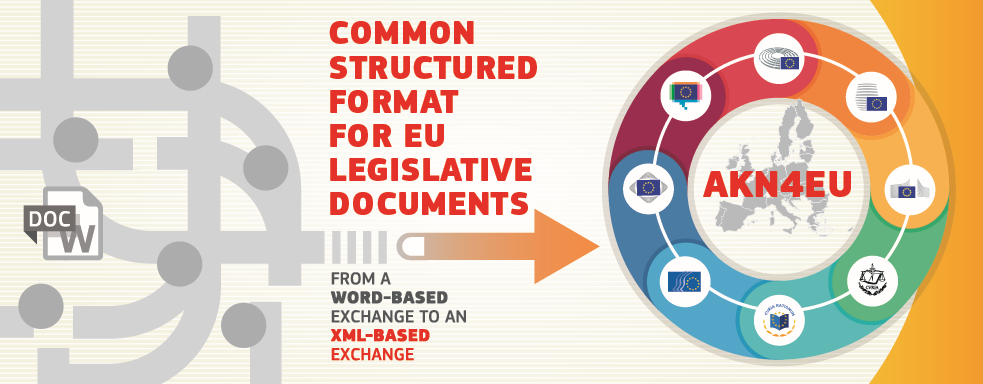Schemas
A schema (XML Schema/XSD file) is a machine-readable representation/description of either the actual or potential data content in a separate file that complies with it. In other words, it is a set of semantic and sequential instructions that can either be used to control the input stored in a given file, or to connect to an information exchange system or application a file that complies with these instructions.

The AKN4EU specifications which serve as the foundation for the development of the validation framework can be found in the "Documentation" tab below, the related schemas and samples are available from the "Download" tab.
The Publications Office has selected BITS (Book Interchange Tag Suite) as an XML mark-up model suitable for the production of general publications.
BITS provides a common XML format in which publishers and archives can exchange book content, including book parts such as chapters. It provides a set of XML DTD and schema that define elements and attributes to describe textual and graphical contents.
In order to facilitate the reusability, BITS makes a tag set adequate for supporting interchange, archiving, format-conversion and publishing. More details can be found here
The Publications Office is preparing the use of the following version of BITS schema customised to meet the requirements of general publications.
The Europass Learning Model can be used to capture the results of any non-formal and formal learning across Europe, as well as the validation of non-formal and informal learning. It is designed to provide a single format to describe certificates of attendance, examination results, degrees and diplomas, diploma supplements, professional certifications, employer recommendations and any other kind of claims that are related to learning.
The Europass Learning Model has been deprecated and replaced by the European Learning Model. Please consult the European Learning Model.
Formex V4 describes the format for the exchange of data between the Publication Office and its contractors. In particular, it defines the logical markup for documents which are published in the different series of the Offical Journal of the European Union. Formex V4 supports also the document types of CASELAW (jurisprudence), CONSLEG (consolidated legislation) and LSEU (legislative summaries).
Formex V4 is based on the international standard format XML (Extensible Markup Language — W3C Recommendation, February 10, 1998). It entered into force on May 1st, 2004. The documentation only exists in English.
A minimum set of metadata elements ("Core Metadata") allows the seamless exchange of (meta)data related to the legal decision making process between the EU institutions, including the Publications Office of the European Union.
Extensions further define optional and institution specific metadata elements. The technical implementation of the Core Metadata and the extension metadata was done as a set of XML schemas.
To ensure smooth interoperability and long term stability, modifications to the IMMC schemas are subject to the governance applied by the Interinstitutional Metadata and Formats Committee (IMFC), metadata subgroup, successor of the original IMMC.
IMMC Core Metadata has two main lines of schemas:
- IMMC Core Metadata for interinstitutional exchanges (formerly IMMCv2) is mainly used for (meta)data exchanges between the EU institutions in the scope of the legal decision making process and related activities.
- IMMC Core Metadata for document production and archiving (formerly IMMCv3) is mainly used in the document production and archiving environment of the Publications Office.
A minimum set of metadata elements ("Core Metadata") allows the seamless exchange of (meta)data related to the legal decision making process between the EU institutions, including the Publications Office of the European Union.
Extensions further define optional and institution specific metadata elements. The technical implementation of the Core Metadata and the extension metadata was done as a set of XML schemas.
To ensure smooth interoperability and long term stability, modifications to the IMMC schemas are subject to the governance applied by the Interinstitutional Metadata and Formats Committee (IMFC), metadata subgroup, successor of the original IMMC.
IMMC Core Metadata has two main lines of schemas:
- IMMC Core Metadata for interinstitutional exchanges (IMMCIIX) (formerly IMMCv2) is mainly used for (meta)data exchanges between the EU institutions in the scope of the legal decision making process and related activities.
- IMMC Core Metadata for document production and archiving (IMMCDPA) (formerly IMMCv3) is mainly used in the document production and archiving environment of the Publications Office.
Based on the Dublin Core metadata element set, the Publications Office of the EU has defined its own OP Core metadata element set. It consists of 16 elements that resources managed and published by the Publications Office through its OP Portal can and should contain. Extensions for specific domains, such as the legal or the general publications domains that go beyond the basic 16 OP Core metadata elements are being defined and will be published on the MDR website as soon as they are ready.
The Publications Office of the EU has defined the Official Journal Electronic Exchange Protocol (OJEEP) to manage the data exchange between PlanJO, the production follow-up system for the Official Journal of the EU, and the contractors in charge of printing the Official Journal.
Multiple schemas are maintained by the Publications Office offering the necessary flexibility to cover all business requirements and at the same time the scalability to adapt easily to changing needs in the data exchange.
OJEEP manages the exchange of manuscripts, models, instructions, proofs, orders, etc.
The Publications Office of the EU has defined the Official Journal Electronic Exchange Protocol (OJEEP) to manage the data exchange between PlanJO, the production follow-up system for the Official Journal of the EU, and the contractors in charge of printing the Official Journal.
Multiple schemas are maintained by the Publications Office offering the necessary flexibility to cover all business requirements and at the same time the scalability to adapt easily to changing needs in the data exchange.
OJEEP manages the exchange of manuscripts, models, instructions, proofs, orders, etc.
| View | Name | |
|---|---|---|